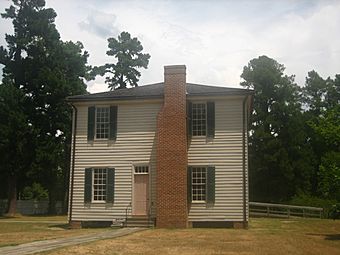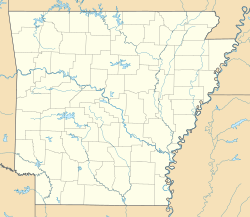Confederate State Capitol building (Arkansas) facts for kids
|
Confederate State Capitol
|
|
|
U.S. Historic district
Contributing property |
|

Main façade of the State House
|
|
| Location | Washington, Arkansas |
|---|---|
| Built | 1836 |
| Architect | Tillman L. Patterson |
| Architectural style | Greek Revival |
| Part of | Washington Historic District (ID72000204) |
| NRHP reference No. | 72000203 |
Quick facts for kids Significant dates |
|
| Added to NRHP | May 19, 1972 |
| Designated NHL | April 19, 1994 |
| Designated CP | June 20, 1972 |
The Confederate State Capitol building in Washington, Arkansas is a very important historical place. It served as the capital for the Confederate government of Arkansas during the American Civil War. This happened from 1863 to 1865. The government moved here after Little Rock, Arkansas was taken by Union forces. Today, the building is part of Historic Washington State Park. It is also recognized as a National Historic Landmark, meaning it's a special place in American history.
Contents
A Special Building in Arkansas
What Does the Capitol Look Like?
This capitol building is a two-story structure made of wood. It is about 44 feet (13 meters) wide and 34 feet (10 meters) deep. The building sits on a strong brick foundation. Its roof is shaped like a hip roof and is covered with cedar shakes.
Each floor has a large main room. The room on the ground floor was once a courtroom. The room upstairs was used by local groups called Masonic societies. The front entrance has a small porch, called a portico. This porch has a triangular top, showing a style called Greek Revival. There are also chimneys on both sides of the building.
A Building with Many Jobs
The building was first built in 1836. It was the second courthouse for Hempstead County. Before this, there was an older log building from 1824. This building served as the county court until 1874. Then, a new brick courthouse was built.
During the American Civil War, something big happened. In September 1863, Union Army forces took control of Little Rock. This was the state capital at the time. Because of this, Governor Harris Flanagin moved the state government. He chose Washington as the new capital. The Confederate state government stayed in this building until the war ended in 1865.
After 1874, the building changed its purpose again. It became a school and taught students until 1914. Later, it was used as a private home until 1928. That year, the state bought the building. This was thanks to the efforts of a local group called the United Daughters of the Confederacy. Now, it is a key part of Historic Washington State Park.
The building was added to the National Register of Historic Places in 1970. In 1994, it became part of a larger group of sites. These sites are all recognized as a National Historic Landmark District.
Learn More About History


